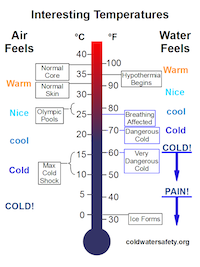What is Cold Water ?
- - -Cold water can kill people in less than a minute.
Thousands of people have drowned after falling into cold water, most Die before even reaching the surface.
You should treat any water temperature below 77F (25C) with caution.
Water Temperature Safety Guide

Below 77F (25C) Breathing begins to be affected.
70-60F (21-15C) Dangerous
Controlling your breathing becomes progressively more difficult from 70°F to 60°F (21°C to 15°C).
You should be wearing a wetsuit or drysuit below 60F, however, 60F (15C)
50-60F (10-15C)
Very Dangerous/Immediately Life-threatening
Total loss of breathing control. Maximum intensity cold shock. Unable to control gasping and hyperventilation.
Cold shock is extreme between 50-60F (10-15C) as it is at 35F (2C).
People will experience a maximum cold shock response somewhere between 50-60F (10-15C).
Most people to completely lose control of their breathing.
Cold shock reaches its maximum intensity between
50-60F (10-15C)
Below 40F (5C) Very Dangerous/Immediately Life-threatening
Total loss of breathing control. Unable to control gasping and hyperventilation. Water feels painfully cold.
Clear thinking becomes almost impossible.
Temperatures
- 98.6F(37C) Normal body temperature measured with an oral thermometer.
- 99.6F(37.5C) Deep body or core temperature measured with a rectal thermometer.
- 95F(35C) For medical purposes, this is the clinical point at whichh hypothermia begins.
- 91F(32.7C) The temperature of your skin.
- 85F(29.4C) Water feels pleasantly cool rather than warm.
- 77-82F(25-28C) Swimming pool temperature range for Olympic competition.
- 70F(21C) Water feels quite cold to most people. Treat any water temperature below 70F (21C) with caution.
- 40F(4.4C) or lower Water is painfully cold.